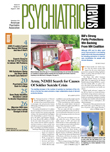Are the revisions of current diagnostic criteria contemplated by the DSM-V Task Force necessary, or even possible?
Robert Spitzer, M.D., who led the development of DSM-III, argues that a true breakthrough in psychiatric diagnoses will occur when biological markers for mental illness are discovered. Until then, he says, the developers of the revised manual are seeking a refinement of diagnosis that oversteps the science, using dimensional criteria for which clinicians are unprepared.
Spitzer told Psychiatric News that he believes DSM-V Task Force leaders are “promising more than they can deliver.”
But the task force leaders, in turn, say 30 years of experience has shown that the patients treated by psychiatrists in their offices do not fit the rigid diagnoses of DSM-III or DSM-IV.
“Comorbidity is a fact of life in clinical psychiatry,” said Renato Alarçon, M.D., a member of the Personality Disorders Work Group.“ A psychotic patient may have obsessive symptoms, a depressed patient may have definite characteristics of borderline personality disorder, and an anxious patient may impulsively attempt to commit suicide. Are these patients only psychotic, depressed, or anxious? Probably not.”
This point was made in a lengthy article by Darrel Regier, M.D., and colleagues in the June American Journal of Psychiatry. Regier is executive director of the American Psychiatric Institute for Research and Education (APIRE), director of APA's Office of Research, and vice chair of the DSM-V Task Force.
In that article, “The Conceptual Development of DSM-V,” the authors outlined the history of research on psychiatric diagnosis and the deficiencies in the now 30-year-old categorical diagnoses of DSM-III: the substantial overlap in symptoms from condition to condition; the failure to distinguish disease presentation at different developmental periods, and among different racial, cultural, and gender groups; and the overuse of “not otherwise specified” (NOS) to categorize patients who do not wholly fit any other category.
Broadly summarizing the article's points in an interview with Psychiatric News, Regier noted that in 1980 Spitzer guided a“ wholesale rewrite” of the preexisting DSM (prior to DSM-III, it had been dominated largely by psychoanalytic constructs) using criteria developed by John Feighner, M.D., Eli Robins, M.D., and Samuel Guze, M.D., at Washington University in 1972. The Washington University group expected that clinical and research experience would prove each syndrome“ valid” by its separation from other disorders, common clinical course, genetic aggregation in families, differentiation by future laboratory tests, and differential response to treatment.
It was not to be.
“After 30 years, there are now many validity tests of the DSM-III to DSM-IV criteria that have not lived up to the expectations of Robins and Guze,” Regier said. “In fact, the criteria have in many respects become reified and have begun to limit scientific and clinical advances.”
So a new approach adding “dimensions” of severity to the existing explicit criteria is being contemplated for DSM-V to add depth and nuance to diagnosis. “This will allow clinicians to precisely and quantitatively describe the severity of their patients' diagnoses and also to describe the full range of their patients' clinically significant problems beyond the 'yes/no' diagnostic categories,” Regier said. “These dimensional ratings will also help researchers, who in the past have been unduly constrained by the reification of the DSM categorical system in the research enterprise.
“We are aiming to develop a diagnostic system that is usable and useful to clinicians. Investigators at APIRE and other institutions have been developing new assessment methods that have been shown to be highly acceptable to clinicians in routine practice, useful, and maintained over time.”
